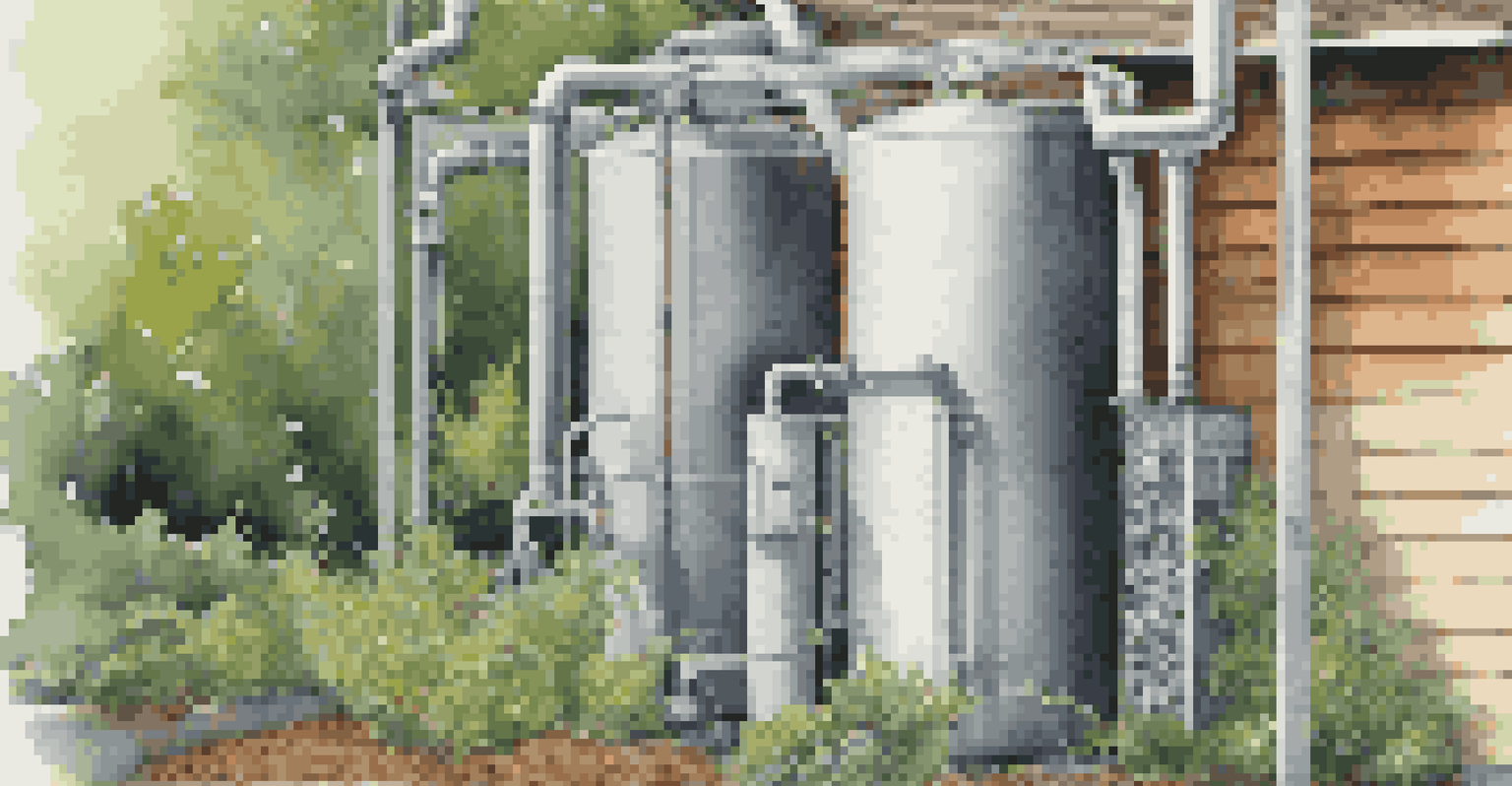Designing Homes with Rainwater Harvesting Systems in Mind

Understanding Rainwater Harvesting Basics
Rainwater harvesting is the process of collecting and storing rainwater for future use. This sustainable practice not only helps in conserving water but also reduces reliance on municipal supply. By understanding how rainwater systems work, homeowners can make informed decisions during the design phase.
Water is the driving force of all nature.
Typically, rainwater is collected from rooftops, stored in tanks, and used for non-potable applications like irrigation and toilet flushing. This approach can significantly lower water bills and lessen the environmental impact of domestic water use. Furthermore, it's a practical step toward self-sufficiency, especially in areas prone to drought.
Integrating rainwater systems into home design can also enhance a property's value. Potential buyers often appreciate eco-friendly features, making your home more appealing in the real estate market. Understanding these basics sets the foundation for thoughtful design choices.
Choosing the Right Location for Collection
The location of your rainwater harvesting system is crucial to its efficiency. Homes with larger roofs or strategically positioned gutters can maximize rainwater collection. Consider factors like regional rainfall patterns, roof material, and surrounding trees that might obstruct water flow.

Placement of collection tanks is equally important. Ideally, these should be near the downspouts for minimal pipe run and maximum efficiency. Additionally, ensure that the site chosen for tanks is accessible for maintenance and inspections to keep the system running smoothly.
Maximize Collection Efficiency
Choosing the right location and design for your rainwater harvesting system is crucial for optimizing water collection and storage.
By carefully selecting the right location for both collection surfaces and storage tanks, homeowners can optimize their rainwater harvesting systems. This thoughtful planning leads to a more effective and sustainable water management solution.
Designing Roofs for Maximum Rainwater Collection
The design of your roof plays a significant role in how much rainwater you can harvest. Sloped roofs can channel water more effectively than flat roofs, so consider incorporating slopes into your design. Materials like metal or tiles can also enhance water runoff, as they are less likely to absorb moisture compared to asphalt shingles.
The greatest threat to our planet is the belief that someone else will save it.
Gutters should be designed to handle heavy rainfall and direct water efficiently towards storage systems. Installing larger gutters or adding additional downspouts can help manage sudden downpours, preventing overflow and maximizing collection. A well-designed roof can significantly increase the volume of rainwater harvested.
Ultimately, a thoughtful roof design not only supports rainwater harvesting but also contributes to the overall aesthetic of the home. Balancing functionality with beauty ensures that your home remains both practical and visually appealing.
Sizing Your Rainwater Storage Tank Properly
When considering rainwater harvesting, choosing the right size for your storage tank is essential. The tank's capacity should reflect your household's water usage and the amount of rainfall in your area. A common rule of thumb is to calculate the roof area and estimate how much water can be collected during peak rainy seasons.
Too small a tank can lead to shortages during dry periods, while an oversized tank may lead to unnecessary costs. It's important to balance your budget with your water collection needs. Consulting with professionals can help you determine the optimal size tailored to your specific situation.
Prioritize Filtration Systems
Incorporating effective filtration and purification systems is essential to ensure the harvested rainwater is safe for its intended use.
Ultimately, properly sizing your rainwater storage tank ensures that you have a reliable source of water throughout the year. This strategic planning contributes to a sustainable lifestyle and enhances your home's resilience against water scarcity.
Incorporating Filtration and Purification Systems
While rainwater is generally clean, incorporating filtration and purification systems is vital for ensuring water quality. Simple mesh filters can remove debris, while more advanced systems can eliminate harmful pathogens, especially if the water is intended for potable use. Understanding the various filtration options available will enhance the effectiveness of your rainwater system.
Choosing the right filtration system depends on the intended use of the harvested rainwater. For irrigation, basic filtration may suffice, but for household use, including drinking, a multi-stage system with UV treatment might be necessary. It's crucial to assess your needs and select a system that guarantees safe water.
By prioritizing filtration and purification in your design, you not only improve water quality but also increase the system's overall efficiency. This proactive approach ensures that your rainwater harvesting system is both functional and safe.
Integrating Rainwater Systems with Landscaping
Rainwater harvesting can seamlessly integrate with your landscaping, promoting a sustainable ecosystem. Utilizing harvested rainwater for irrigation can reduce dependency on municipal water sources and support plant health. Designing your garden with native plants that thrive on collected rainwater can create a beautiful, low-maintenance landscape.
Rain gardens, which are designed to capture and filter runoff, can be an excellent addition. These gardens not only beautify your property but also enhance water absorption into the ground, reducing erosion. This creates a harmonious balance between your home and the natural environment.
Regular Maintenance is Key
Consistent maintenance of your rainwater harvesting system helps prolong its lifespan and ensures high water quality.
By incorporating rainwater systems into your landscaping design, you can create a cohesive and sustainable outdoor space. This thoughtful integration leads to a resilient landscape that supports both your home and the ecosystem.
Maintaining Your Rainwater Harvesting System
Like any home system, regular maintenance is key to the longevity of your rainwater harvesting system. This includes routine checks on gutters, filters, and tanks to ensure everything is functioning correctly. Simple tasks, like cleaning gutters and inspecting for leaks, can prevent larger issues down the line.
Establishing a maintenance schedule helps keep your system in optimal condition and ensures water quality remains high. It’s also beneficial to familiarize yourself with the components of your system, so you can address any concerns that arise. Proper maintenance is the best way to protect your investment.

Ultimately, maintaining your rainwater harvesting system not only extends its life but also ensures you reap the full benefits of your sustainable design. Consistent attention to these systems fosters a culture of sustainability in your home.